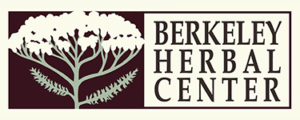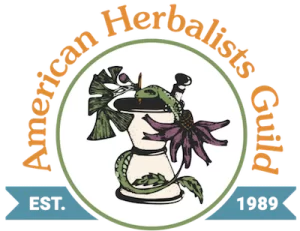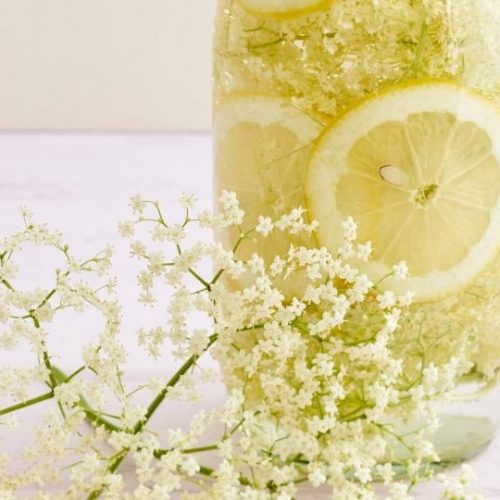
That soft scent floating across the warm summery wind is elderflower.
And it’s almost time to march into the wet wilds and snip a few umbels of this delightful ally for your summer teas and syrups!
We’ve shared our late summer elderberry syrup recipe before, but Elder is an transformative ally that offers us healing love starting late spring, throughout summer time and late into the fall!
We want to share a bit about the ancient, lore-inspired medicinal tree along with offering you an elderflower syrup recipe you can keep throughout the year.
Elder is a veritable medicine chest. The leaves, bark, berry and flower all contain healing properties that can help your body prevent illness and heal over time.
Elder is a large shrub or a small tree. From late spring until early summer these are easy to identify because you’ll see masses of tiny white (or lacey-yellow) umbels of small flowers scattered throughout the compound leaves. You’ll find that the leaves had small serrated edges.
The flowers have a faint smell that is sweet with musky undertones. The flowers bruise easily and don’t last very long before they begin their berry transformation. The elderberry that we use is always dark purple to black.
There are more than 200 species of elder throughout the world, so identification can be tricky. This is especially important because there is evidence that some types of elder can cause illness.
There are two common elders that we use interchangeably, Sambucus nigra and Sambucus canadensis. Sambucus nigra refers to the tree and Sambucus canadensis refers to the common shrub.
Best advice – make sure that you’re harvesting from a Sambucus that has dark purple or black berries. Watchout! Red berried elder is common and can make you sick.
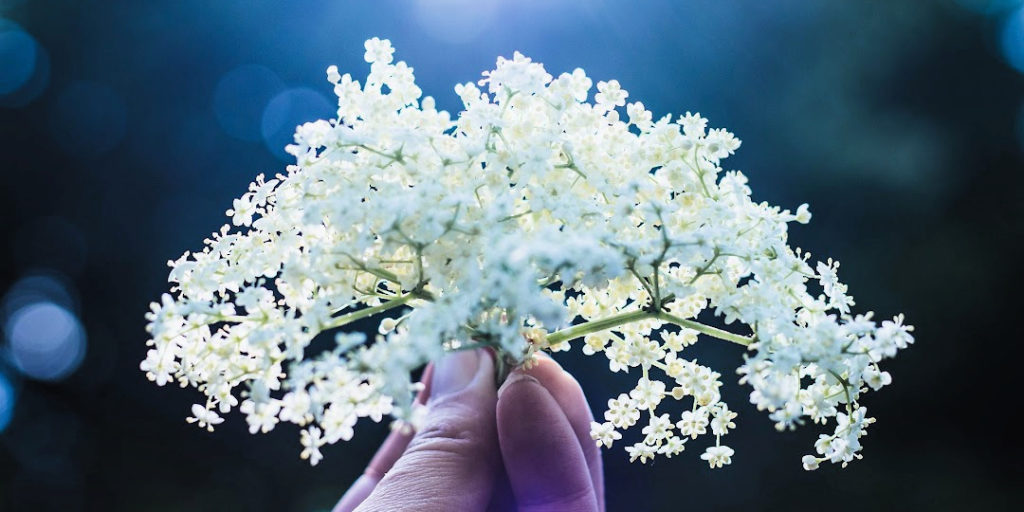
Elder is an ancient plant that has been used medicinally and within ceremony for thousands of years, so there is a lot of lore circling around Elder.
The Celtics found this ally to be a gateway plant. It can aid the sacred connection to the transitional spaces of life and death. Elder trees are also a known gateway to the Fairy realm. And like many things deeply rooted in Fairy lore, there are many stories (often contradictory) around working with this plant in connection with the little people.
For instance, it’s never a good idea to nap under an elder tree, use it to make a baby basket, or in some stories even bring the wood across the threshold of your home for fear of angering the spirits and causing madness! Similarly, many cultures do not use elder for firewood or for woodworking because it brings spiritual wrath.
On the other hand, Elder is also known to be a great protector from evil! Plant it and work with its growing form to encourage prosperity, happiness and health in the home – including protection from evil forces.
From our standpoint – work with Elder as you would with all plants that you’re working with. Be a steward for her. Keep your intentions positive and pay attention to her needs. Have respect for the spirit of this plant, for she is unafraid of teaching you this lesson herself.
Ah, but we’re here to talk about working with the late spring loveliness of this shrub – Elderflower!
You want to get to the flower when they’re really fresh because they don’t last long and they bruise easily.
Elderflower starts poking through the leaves of the plants in May and throughout June.
To collect them, snip the whole umbel. The best time is in the morning after the dew dries completely. They’re even easier to damage when they’re wet, and they’re at their fullest just after a little morning dew collection!
As with any kind of wild harvesting of plants you really want to make sure that:
When we think about elderflower, we think of a general soothing. That lovely, powerful friend that lets you know things are going to be okay.
The flower essence of the Elder helps open people to their own inner strength and self-esteem. It helps people to find calm from internal fears through nourishing their own inner stability. This is a lovely essence to use with folks who feel overwhelmed or stuck in fears they know come from within.
Aside from their calming essence, elderflower has a long healing history. Like their well known berry counterpart, they can be used to help the body prevent colds and flu. This is especially true for respiratory issues, sinuses, and congestion. It is especially helpful when you’re working with stuck dampness or heaviness because brings up stuck catarrh, clears heat, and calms irritated tissues.
Elderflower is gentle in its action. While some herbal allies can be too strong for kids, someone with a prolonged illness, pregnant women, or the elderly, elderflower is lovely for these most sensitive folks. It gently helps the body find balance while holding space for healing from viral and bacterial loads.
It’s also yummy and sweet, of course! That makes it so much easier to offer as a medicinal treat.
Most commonly, you can take it as a fresh tea or make a strong decoction – it’s delicious and healing in a minty lemonade!
Because it doesn’t bloom for more than a month or two every year, “how do I preserve my elderflower?” is a common question. Of course you can dry the flowers and keep them in a cool, dry, dark place. Elderflowers are easily bruised so drying them needs a bit of care, and the medicine does lose strength over time.
You can also make this part of the plant into a tincture, but you’ll lose the yummy flavor and some of the magic of the plant.
For a really unique way to work with elderflower all year, you can infuse it directly into honey or turn it into a delicious (and nourishing) elderflower syrup!
You can take elderflower syrup directly, use it in your daily tea as a sweetener, or even add it to your formulas for extra flavor!
Elderflower syrup mixed with sparkling water is very, very refreshing after a long hike through the mountains!
Spruce up your refreshing drink for an herb-y after hours delight, just add a sprig of mint, a nip of gin, and an orange peel and you’ve got yourself a delicious elderflower cocktail!
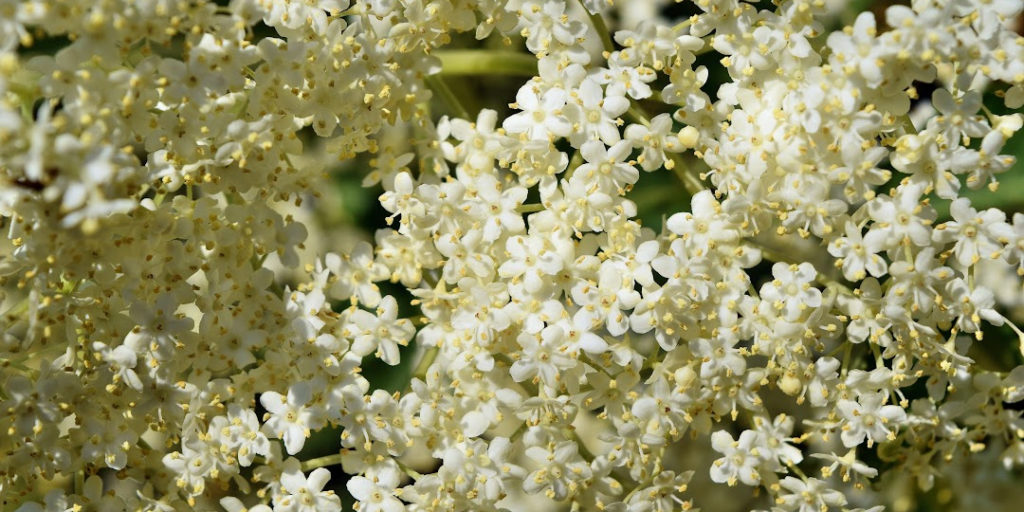
This elderflower syrup is adapted from an old Dutch family recipe. It’s a beautiful example of how our herbal wisdoms pass to us through generations of healers and wildcrafters.
This is very familiar to a simple syrup so the original recipe contains a lot of sugar. Consider replacing the sugar with honey and reduce the water by up to half (for consistency).
Consider using a slow cooker for this recipe since it takes 24 hours to make. If you’re using a stove, make sure that the water doesn’t evaporate too much
This recipe takes time, so it’s often quadrupled. If you’re planning on making a lot and storing it, add 2 teaspoons of citric acid per cup to preserve.
References:
Support Our Work
Berkeley Herbal Center is a 501(c)(3) organization, so all donations are tax deductible. Tax ID #14-1975183
If you would like to donate by check or cash, please send an envelope addressed to:
Berkeley Herbal Center
1250 Addison St., #G
Berkeley, CA 94702
